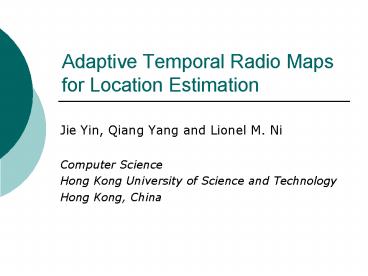Adaptive Temporal Radio Maps for Location Estimation - PowerPoint PPT Presentation
1 / 24
Title:
Adaptive Temporal Radio Maps for Location Estimation
Description:
Hong Kong University of Science and Technology. Hong Kong, China. 2. Introduction ... Build a radio map by calibrating signal-strength samples from access points at ... – PowerPoint PPT presentation
Number of Views:59
Avg rating:3.0/5.0
Title: Adaptive Temporal Radio Maps for Location Estimation
1
Adaptive Temporal Radio Maps for Location
Estimation
- Jie Yin, Qiang Yang and Lionel M. Ni
- Computer Science
- Hong Kong University of Science and Technology
- Hong Kong, China
2
Introduction
- Location estimation based on IEEE 802.11b
wireless networks has gained increasing attention - GPS does not work indoor
- Radio Frequency (RF) wireless networks
- Challenges
- The signal strength is inherently uncertain due
to multi-path fading effects - Environmental dynamics affect the signal strength
to a large extent
3
Static Localization
- Input
- Output
- Given a new signal-strength vector
- lt-63,-87,-79gt
- ? predict a mobile user to be in location2
4
Common Approaches
- Based on a two-phase algorithm
- Offline training phase
- Build a radio map by calibrating signal-strength
samples from access points at selected locations
- Online localization phase
- Real-time signal-strength samples are used to
search the radio map to estimate the locations
5
Related Work
- The RADAR system Infocom00
- Deterministic nearest neighbor
- Robotics based system Mobicom02
- The Bayesian inference method
- Post-processing used for refinement
- Joint clustering based system Percom03
- Maximum Likelihood (ML) method
6
Problem with Static Localization
- Assumption static radio map
- Once learned in the offline phase, a radio map is
applied to estimate locations in any later time
periods without adaptation - ? Inaccurate location estimation
- The signal-strength samples collected in the
online phase may significantly deviate from those
stored in the radio map.
7
Problem with Static Localization
- Signal-strength distributions vary over different
time periods - Naïve approach repeatedly rebuild radio maps
- ? Too tedious manual effort
- ? Does not work day-to-day variations
8
Our Solution
- Key idea adapt the radio map based on reference
points using a regression analysis
9
Definitions
- Location space L
- Each tuple represents a users location and
orientation - p access points and m reference points
- The signal strength received by a mobile client
is defined as - The signal strength received at the kth reference
point is
10
Two-phase Algorithm (1)
- During the offline phase (time period t0),
- At each location, we learn a predictive function
fij for the jth access point - fij indicates the relationship between the
signal-strength values received at reference
points and the value received by the mobile client
11
Two-phase Algorithm (2)
- During the online phase (time period t),
- Based on the signal strength received at
reference points, we compute the estimated
signal-strength vector
for each location using fij - The signal strength received by the mobile client
is referred as - Compute the Euclidean distance Di and output the
location with minimum distance
12
Critical Issue
- To learn the predictive function fij between the
signal-strength values received by the mobile
client and the reference points. - Two algorithms via regression analysis
- A multiple-regression based algorithm
- A model-tree based algorithm
13
Multiple Regression
- The signal strength received by the mobile client
is computed as a linear aggregate of the signal
strength received at m reference points - Regression coefficients represent the
independent contributions of each reference point - Perform least square estimation to compute
regression coefficients in the offline phase
14
Model Tree
- Piecewise linear approximation
- Multiple regression vs model tree
15
Model Tree
- A model tree is a binary decision tree with
linear regression functions at the leaf nodes
16
Experimental Setup
Access points Reference points
A section of office area in CS department
17
Data Collection
- Reference points on every other hour from early
morning to midnight (800AM- 1200AM) - Grid points
- Each position is 1.5 meters apart
- 450 samples per position with two directions
- Evaluation Data
- The group of data collected at midnight 1200AM
for training - The other eight independent groups for testing
18
Impact of Environmental Factors
- Comparison of overall accuracy over different
time periods
19
Impact of Environmental Factors
- Comparison of accuracy within 1.5 meters over
different time periods
20
Impact of Reference Points
- Comparison of average accuracy vs the number of
reference points at 800AM
21
Impact of Access Points
- Comparison of average accuracy vs the number of
access points at 1200PM
22
Conclusions
- We present a novel localization method based on
temporal radio maps - Reference points and regression analysis
- Our proposed method can adapt better to the
variations of signal strength caused by
environmental dynamics
23
Future Work
- Apply more effective probabilistic methods to
build radio maps using the signal strength
received at reference points - Incorporate a users movement trajectories to
improve accuracy - Test the validity of our proposed algorithms in a
larger-scale environment
24
Questions?
- Thank you































